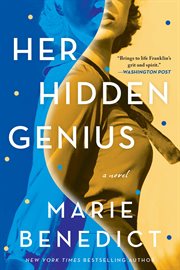Review by Booklist Review
Award-winning author Stone introduces younger readers to molecular biologist Rosalind Franklin, whose X-ray diffraction photograph illuminating the double helix structure of DNA led to Watson and Crick receiving the Nobel Prize, although they never credited her contribution. London-born Franklin began her career working to improve gas masks during WWII, took a job in Paris where she developed skills as an X-ray crystallographer, and returned to work at King's College using her expertise in the study of DNA. Stone emphasizes Franklin's dedication to her work, her love of the outdoors, and her continuing efforts to ignore the slights from her male colleagues. Occasionally, Stone's narrative breaks the fourth wall, telling readers this is a true story without a happy ending, and later pointing out Rosalind's lack of musical aptitude ("One cannot be good at everything"). Powers' watercolor illustrations feature a pastel palette of greens and tans with navy and rose used as accents. Many spreads employ decorative borders, resulting in a pleasing, nostalgic feel. An author's note provides additional information about Franklin and details the Matilda effect, which explains how women's accomplishments are often systematically overlooked. Source notes and a bibliography round out the back matter of this compelling introduction to an extraordinary scientist.
From Booklist, Copyright (c) American Library Association. Used with permission.
Review by Horn Book Review
Stone's dedication -- "For anyone who did something awesome and didn't feel the love" -- sets the reparative tone for this picture-book biography of scientist Franklin (1920âe"1958), whose Photo 51 cracked the DNA code while competing researchers James Watson and Francis Crick took the credit (and the 1962 Nobel Prize). As she weaves science and history, Stone unravels dual mysteries centering on the double helix: how the "secret of life...makes you -- YOU" and how a "twist of fate" triggered Franklin's posthumous recognition. Powers's watercolors perfectly blend representative and expressive styles. Realistically rendered characters and period details set the story in its mid-twentieth-century milieu, while experimental techniques offer evocative visual commentary; for example, when Franklin argues with Watson and Crick, blue watercolor blotches disrupt the tidy floral border and explode the ground beneath them. Although Stone opens by warning, "This true story doesn't really have a happy ending," Powers's accompanying fairy taleâe"esque castle, adorned with scientific instruments, foreshadows a time in which readers are empowered to interrogate the historical record and reclaim the stories of little-heralded figures. An author's note explains the Matilda Effect, a historical pattern in which men take credit for women's work. Shelley IsaacsonJanuary/February 2024 p.122 (c) Copyright The Horn Book, Inc., a wholly owned subsidiary of Media Source, Inc. No redistribution permitted.
(c) Copyright The Horn Book, Inc., a wholly owned subsidiary of Media Source, Inc. No redistribution permitted.
Review by Kirkus Book Review
A profile of the underrecognized DNA researcher whose work sparked Crick and Watson's breakthrough. "This true story doesn't really have a happy ending," Stone warns--after dedicating the book to "anyone who did something awesome and didn't feel the love." In recent years, Rosalind Franklin's role in revealing DNA's helical structure has come to be readily acknowledged…but it wasn't at the time. Along with noting the fishy way her famous "Photo 51" came into Crick and Watson's possession, the author offers several condescending quotes from Watson's 1968 memoir along the lines of "she was not unattractive" and "there was no denying she had a good brain." Ouch. Counterintuitively, considering the infuriating injustice here, Powers echoes the narrative's informal, almost detached tone with illustrations more restrained than angry; her subject bears delicate features and a distant, abstracted gaze, and the artist relies on misty, pale hues and softly rounded forms. Whatever their reaction to what the author pegs in her afterword as an archetypal case study in the Matilda effect (men taking credit for women's work), readers will come away with a clear understanding of Franklin's contributions, as well as her distinctive scientific skills and background. A warmly appreciative tribute to a renowned scientist. (citations for quotes used in book, source list, photos) (Picture-book biography. 7-9) Copyright (c) Kirkus Reviews, used with permission.
Copyright (c) Kirkus Reviews, used with permission.

